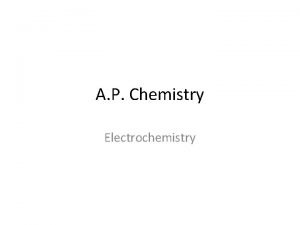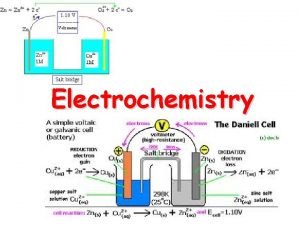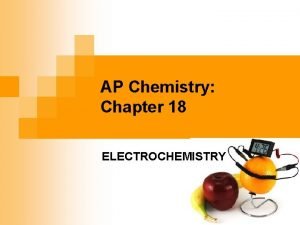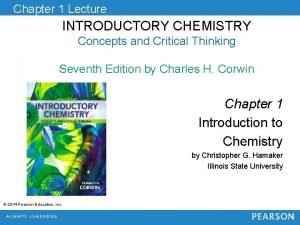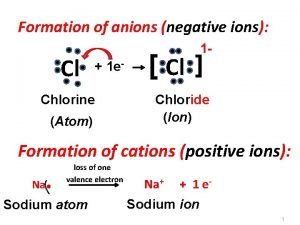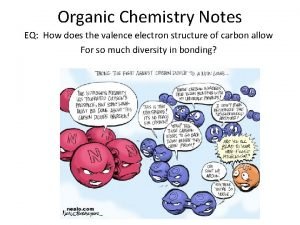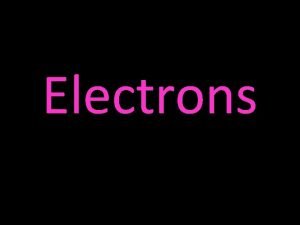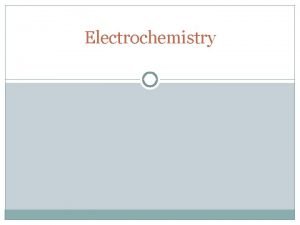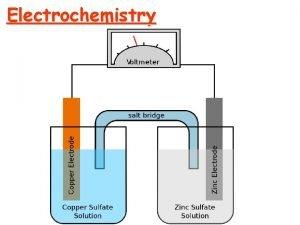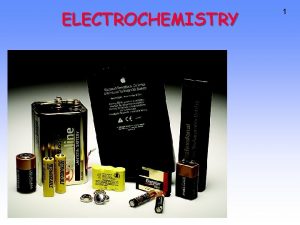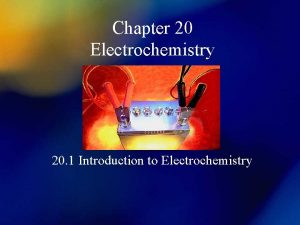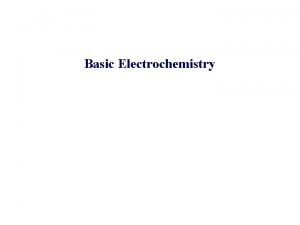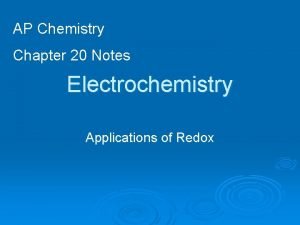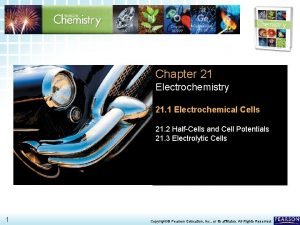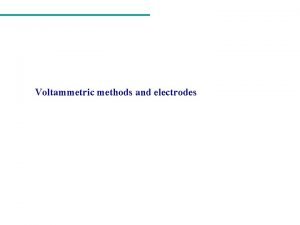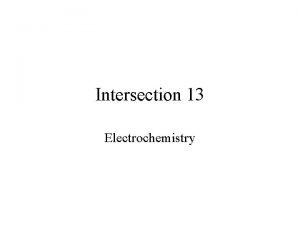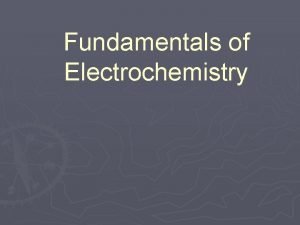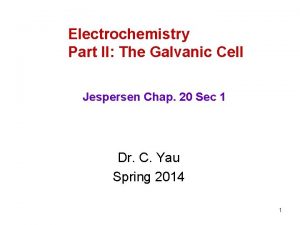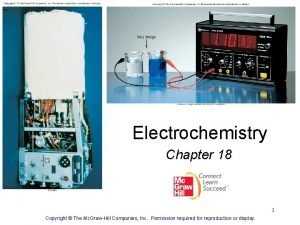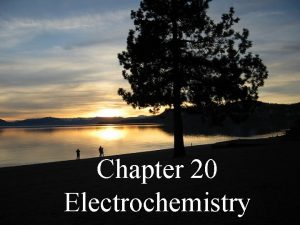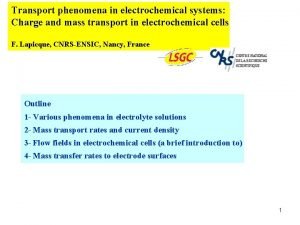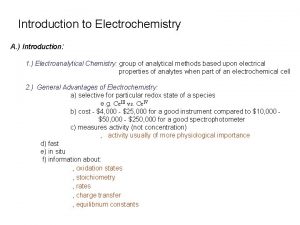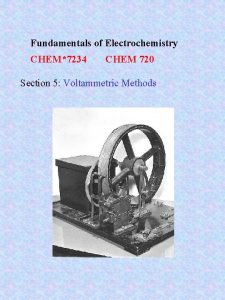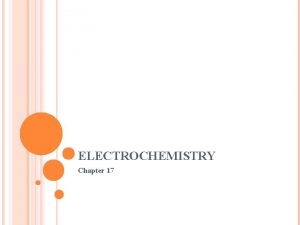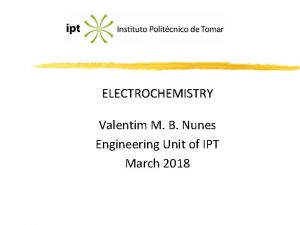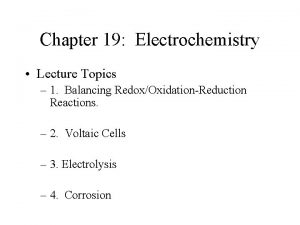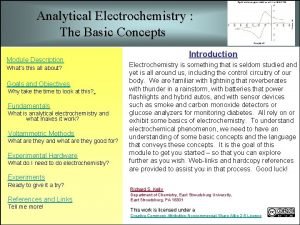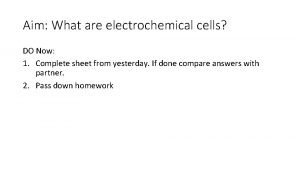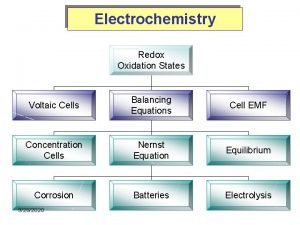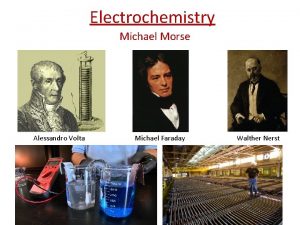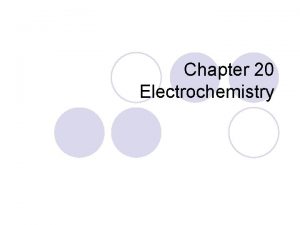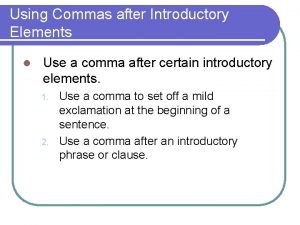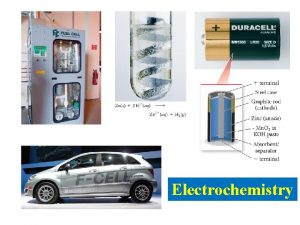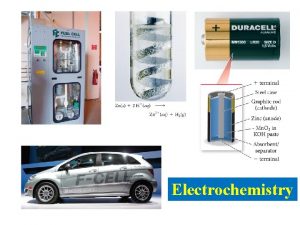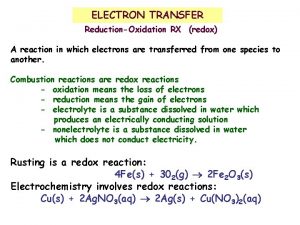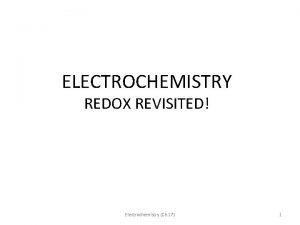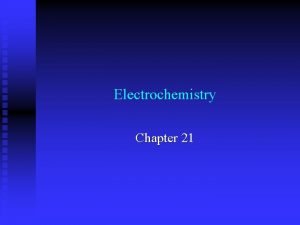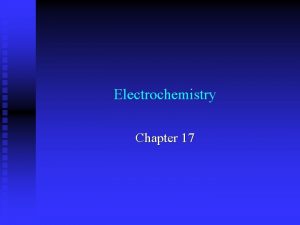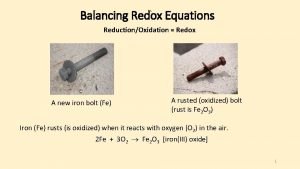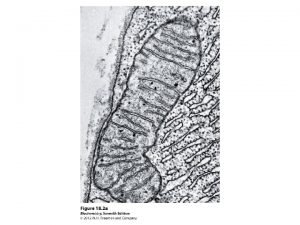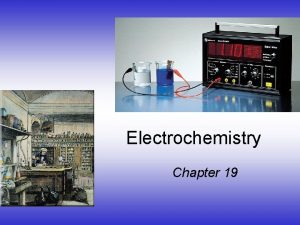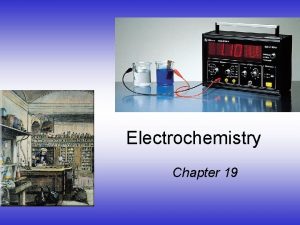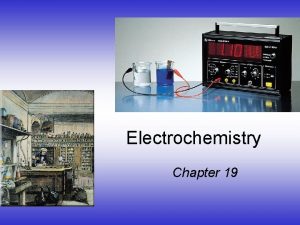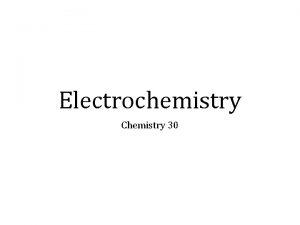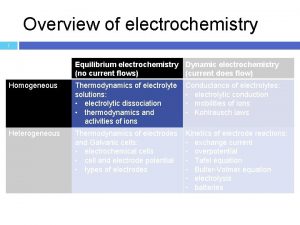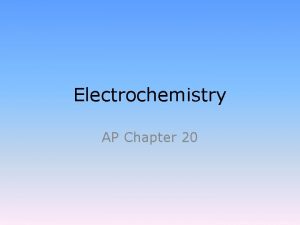Electrochemistry ELECTRON TRANSFER ReductionOxidation RX redox INTRODUCTORY CHEMISTRY
























































































- Slides: 88

Electrochemistry

ELECTRON TRANSFER Reduction-Oxidation RX (redox) INTRODUCTORY CHEMISTRY APPROACH A reaction in which electrons are transferred from one species to another. Combustion reactions are redox reactions - oxidation means the loss of electrons - reduction means the gain of electrons - electrolyte is a substance dissolved in water which produces an electrically conducting solution - nonelectrolyte is a substance dissolved in water which does not conduct electricity. Rusting is a redox reaction: 4 Fe(s) + 302(g) 2 Fe 2 O 3(s) Electrochemistry involves redox reactions: Cu(s) + 2 Ag. NO 3(aq) 2 Ag(s) + Cu(NO 3)2(aq)

IDENTIFING REDOX RX INTRODUCTORY CHEMISTRY APPROACH Element + compound New element + New compound A + BC B + AC Element + Element Compound A + B AB Check oxidation state (charges) of species A change in oxidation # means redox reaction Identify the Redox Rx: Cu + Ag. NO 3 Cu(NO 3)2 + Ag NO + O 2 NO 2 K 2 SO 4 + Ca. Cl 2 KCl + Ca. SO 4 C 2 H 4 O 2 + O 2 CO 2 + H 2 O

LABELING COMPONENTS OF REDOX REACTIONS GENERAL CHEMISTRY APPROACH The REDUCING AGENT is the species which undergoes OXIDATION. The OXIDIZING AGENT is the species which undergoes REDUCTION. Cu. O + H 2 Cu + H 2 O

Workshop EC #1 1) Determine the oxidation state of each component in the following substances. 2) Identify the Oxidizing and Reducing Agents in Each of the Following 3 H 2 S + 2 NO 3– + 2 H+ S + 2 NO + 4 H 2 O Mn. O 2 + 4 HBr Mn. Br 2 + 2 H 2 O 5

A summary of redox terminology. Zn(s) + 2 H+(aq) Zn 2+(aq) + H 2(g) OXIDATION One reactant loses electrons. Zn loses electrons. Reducing agent is oxidized. Zn is the reducing agent and becomes oxidized. Oxidation number increases. The oxidation number of Zn increases from 0 to +2. REDUCTION Other reactant gains electrons. Oxidizing agent is reduced. Hydrogen ion gains electrons. Hydrogen ion is the oxidizing agent and becomes reduced. Oxidation number decreases. The oxidation number of H decreases from +1 to 0.

Key Points About Redox Reactions • Oxidation (electron loss) always accompanies reduction (electron gain). • The oxidizing agent is reduced, and the reducing agent is oxidized. • The number of electrons gained by the oxidizing agent always equals the number lost by the reducing agent.

ACTIVITY SERIES OF SOME SELECTED METALS A brief activity series of selected metals, hydrogen and halogens are shown below. The series are listed in descending order of chemical reactivity, with the most active metals and halogens at the top (the elements most likely to undergo oxidation). Any metal on the list will replace the ions of those metals (to undergo reduction) that appear anywhere underneath it on the list. METALS HALOGENS K (most oxidized, strong reducing agent) F 2 (relatively stronger oxidizing agent) Ca Cl 2 Na Br 2 Mg l 2 (relatively weaker oxidizing agent) Al Zn Fe Ni Sn Oxidation refers to the loss of Pb electrons and reduction refers to the H gain of electrons Cu Ag Hg Au(least oxidized)

Strongest oxidizing agent Oxidizing/Reducing Agents Most positive values of E° red F 2(g) + 2 e- • • H 2(g) • + Li(s) Most negative values of E° red Li+(aq) Increasing strength of reducing agent • 2 H+(aq) + 2 e- Increasing strength of oxidizing agent 2 F-(aq) e- Strongest reducing agent

Standard Reduction Potentials in Water at 25°C Standard Potential (V) 2. 87 1. 51 1. 36 1. 33 1. 23 1. 06 0. 96 0. 80 0. 77 0. 68 0. 59 0. 54 0. 40 0. 34 0 -0. 28 -0. 44 -0. 76 -0. 83 -1. 66 -2. 71 -3. 05 Reduction Half Reaction F 2(g) + 2 e- 2 F-(aq) Mn. O 4 -(aq) + 8 H+(aq) + 5 e- Mn 2+(aq) + 4 H 2 O(l) Cl 2(g) + 2 e- 2 Cl-(aq) Cr 2 O 72 -(aq) + 14 H+(aq) + 6 e- 2 Cr 3+(aq) + H 2 O(l) O 2(g) + 4 H+(aq) + 4 e- 2 H 2 O(l) Br 2(l) + 2 e- 2 Br-(aq) NO 3 -(aq) + 4 H+(aq) + 3 e- NO(g) + H 2 O(l) Ag+(aq) + e- Ag(s) Fe 3+(aq) + e- Fe 2+(aq) O 2(g) + 2 H+(aq) + 2 e- H 2 O 2(aq) Mn. O 4 -(aq) + 2 H 2 O(l) + 3 e- Mn. O 2(s) + 4 OH-(aq) I 2(s) + 2 e- 2 I-(aq) O 2(g) + 2 H 2 O(l) + 4 e- 4 OH-(aq) Cu 2+(aq) + 2 e- Cu(s) 2 H+(aq) + 2 e- H 2(g) Ni 2+(aq) + 2 e- Ni(s) Fe 2+(aq) + 2 e- Fe(s) Zn 2+(aq) + 2 e- Zn(s) 2 H 2 O(l) + 2 e- H 2(g) + 2 OH-(aq) Al 3+(aq) + 3 e- Al(s) Na+(aq) + e- Na(s) Li+(aq) + e- Li(s)

Workshop EC#2 on REDOX AGENTS 1) For the following reactions, identify the oxidizing and reducing agents and then determine if they are strong or weak agents. Mn. O 4 - + C 2 O 42 - Mn. O 2 + CO 2 As + Cl. O 3 - H 3 As. O 3 + HCl. O 2) Which of the following species is the strongest oxidizing agent: NO 3 -(aq), Ag+(aq), or Cr 2 O 72 -(aq)?

Half-Reaction Method for Balancing Redox Reactions Summary: This method divides the overall redox reaction into oxidation and reduction half-reactions. • Each reaction is balanced for mass (atoms) and charge. • One or both are multiplied by some integer to make the number of electrons gained and lost equal. • The half-reactions are then recombined to give the balanced redox equation. Advantages: • The separation of half-reactions reflects actual physical separations in electrochemical cells. • The half-reactions are easier to balance especially if they involve acid or base. • It is usually not necessary to assign oxidation numbers to those species not undergoing change.

The guidelines for balancing via the half-reaction method are found below: 1. Write the corresponding half reactions. 2. Balance all atoms except O and H. 3. Balance O; add H 2 O as needed. 4. Balance H as acidic (H+). 5. Add electrons to both half reactions and balance. 6. Add the half reactions; cross out “like” terms. 7. If basic or alkaline, add the equivalent number of hydroxides (OH-) to counterbalance the H+ (remember to add to both sides of the equation). Recall that H+ + OH- H 2 O.

ELECTROCHEMISTRY Balancing Redox Reactions: acidic: Cr 2 O 72 - + Fe 2+ Cr 3+ + Fe 3+ Basic: Co 2+ + H 2 O 2 Co(OH)3 + H 2 O Balance the following in both acidic and basic environments: H 2 O 2 + Cr 2 O 72 - O 2 + Cr 3+

Workshop EC#3 on REDOX REACTIONS Balance the following reactions. Mn. O 4 - + C 2 O 42 - Mn. O 2 + CO 2 As + Cl. O 3 - H 3 As. O 3 + HCl. O

Electric Current Flowing Directly Between Atoms

ELECTROCHEMICAL CELLS CHEMICALS AND EQUIPMENT NEEDED TO BUILD A SIMPLE CELL: The Cell: Voltmeter Two alligator clips Two beakers or glass jars The Electrodes: Metal electrode Metal salt solution The Salt Bridge: Glass or Plastic u-tube. Na or K salt solution

ELECTROCHEMISTRY A system consisting of electrodes that dip into an electrolyte and in which a chemical reaction uses or generates an electric current. Two Basic Types of Electrochemical cells: Galvanic (Voltaic) Cell: A spontaneous reaction generates an electric current. Chemical energy is converted into electrical energy Electrolytic Cell: An electric current drives a nonspontaneous reaction. Electrical energy is converted into chemical energy.

General characteristics of voltaic and electrolytic cells. VOLTAIC CELL System Energydoes is released work on from its spontaneous surroundings redox reaction Oxidation half-reaction X X + + e- ELECTROLYTIC CELL Surroundings(power Energy is absorbed tosupply) drive a nonspontaneous redox reaction do work on system(cell) Oxidation half-reaction AA + e- Reduction half-reaction Y+ + e - Y Reduction half-reaction B+ + e B Overall (cell) reaction X + Y+ X+ + Y; G < 0 Overall (cell) reaction A- + B + A + B; G > 0

Electric Current Flowing Indirectly Between Atoms

Voltaic Cell the salt bridge is required to complete the circuit and maintain charge balance

ELECTROCHEMICAL CELLS A CHEMICAL CHANGE PRODUCES ELECTRICITY Theory: If a metal strip is placed in a solution of it’s metal ions, one of the following reactions may occur Mn+ + ne- M M Mn+ + ne. These reactions are called half-reactions or half cell reactions If different metal electrodes in their respective solutions were connected by a wire, and if the solutions were electrically connected by a porous membrane or a bridge that minimizes mixing of the solutions, a flow of electrons will move from one electrode, where the reaction is M 1 n+ + ne. To the other electrode, where the reaction is M 2 n+ + ne- M 2 The overall reaction would be M 1 + M 2 n+ M 2 + M 1 n+

Electrochemical Cells An electrochemical cell is a device in which an electric current (i. e. a flow of electrons through a circuit) is either produced by a spontaneous chemical reaction or used to bring about a nonspontaneous reaction. Moreover, a galvanic (or voltaic) cell is an electrochemical cell in which a spontaneous chemical reaction is used to generate an electric current. Consider the generic example of a galvanic cell shown below:

The cell consists of two electrodes, or metallic conductors, that make electrical contact with the contents of the cell, and an electrolyte, an ionically conducting medium, inside the cell. Oxidation takes place at one electrode as the species being oxidized releases electrons from the electrode. We can think of the overall chemical reaction as pushing electrons on to one electrode and pulling them off the other electrode. The electrode at which oxidation occurs is called the anode. The electrode at which reduction occurs is called the cathode. Finally, a salt bridge is a bridge-shaped tube containing a concentrated salt in a gel that acts as an electrolyte and provides a conducting path between the two compartments in the electrochemical circuit.

Voltaic Cells (1 of 3) In spontaneous redox reactions, electrons are transferred and energy is released. That energy can do work if the electrons flow through an external device. This is a voltaic cell.

Voltaic Cells (2 of 3) The oxidation occurs at the anode. The reduction occurs at the cathode. When electrons flow, charges aren’t balanced. So, a salt bridge, usually a U-shaped tube that contains a salt/agar solution, is used to keep the charges balanced.

Voltaic Cells (3 of 3) In the cell, electrons leave the anode and flow through the wire to the cathode. Cations are formed in the anode compartment. As the electrons reach the cathode, cations in solution are attracted to the now negative cathode. The cations gain electrons and are deposited as metal on the cathode.

Why Does a Voltaic Cell Work? The spontaneous reaction occurs as a result of the different abilities of materials (such as metals) to give up their electrons and the ability of the electrons to flow through the circuit. Ecell > 0 for a spontaneous reaction 1 Volt (V) = 1 Joule (J)/ Coulomb (C)

Cell Potentials

More Positive EºRed (V) A cell will always run spontaneous Eº Red (cathode) in the direction that produces a Eº cell o positive E cell Eº (anode) Cathode(reduction) red Anode(oxidation) More Negative

A voltaic cell based on the zinc-copper reaction. Oxidation half-reaction Zn(s) Zn 2+(aq) + 2 e- Reduction half-reaction Cu 2+(aq) + 2 e. Cu(s) Overall (cell) reaction Zn(s) + Cu 2+(aq) Zn 2+(aq) + Cu(s)

Notation for a Voltaic Cell components of anode compartment components of cathode compartment (oxidation half-cell) (reduction half-cell) phase of lower oxidation state phase of higher oxidation state phase of lower oxidation state phase boundary between half-cells Zn(s) | Zn 2+(aq) || Cu 2+(aq) | Cu (s) Examples: Zn(s) Zn 2+(aq) + 2 e- Cu(s) graphite | I-(aq) | I 2(s) || H+(aq), Mn. O 4 -(aq) | Mn 2+(aq) | graphite inert electrode

NOTATION FOR VOLTAIC CELLS Zn + Cu 2+ Zn 2+ + Cu Zn(s)/Zn 2+(aq) // Cu 2+(aq)/Cu(s) Anode Cathode oxidation reduction salt bridge write the net ionic equation for: Al(s)/Al 3+(aq)//Cu 2+(aq)/Cu(s)

Standard Reduction Potential • a half-reaction with a strong tendency to occur has a large + half-cell potential • when two half-cells are connected, the electrons will flow so that the half-reaction with the stronger tendency will occur • we cannot measure the absolute tendency of a half-reaction, we can only measure it relative to another half-reaction • we select as a standard half-reaction the reduction of H+ to H 2 under standard conditions, which we assign a potential difference = 0 v – standard hydrogen electrode, SHE 34

Standard Hydrogen Electrode Their reference is called the standard hydrogen electrode (SHE). By definition as the standard, the reduction potential for hydrogen is 0 V:


If given: Al(s)→Al 3+(aq)+3 e- and 2 H+(aq)+2 e-→H 2(g) write the notation. The Hydrogen Electrode (Inactive Electrodes): At the hydrogen electrode, the half reaction involves a gas. 2 H+(aq) + 2 e- H 2(g) so an inert material must serve as the reaction site (Pt). Another inactive electode is C(graphite). H+(aq)/H 2(g)/Pt cathode Pt/H 2(g)/H+(aq) anode Therefore: Al(s)/Al 3+(aq)//H+(aq)/H 2(g)/Pt

What is the notation for this cell? Fe(s) | Fe 2+(aq) || Mn. O 4 (aq), H+(aq) | Mn 2+(aq), | Pt(s) 38

Sample Problem: PROBLEM: PLAN: Diagramming Voltaic Cells Diagram, show balanced equations, and write the notation for a voltaic cell that consists of one half-cell with a Cr bar in a Cr(NO 3)3 solution, another half-cell with an Ag bar in an Ag. NO 3 solution, and a KNO 3 salt bridge. Measurement indicates that the Cr electrode is negative relative to the Ag electrode. Identify the oxidation and reduction reactions and write each halfreaction. Associate the (-)(Cr) pole with the anode (oxidation) and the (+) pole with the cathode (reduction). SOLUTION: Voltmeter e- Oxidation half-reaction Cr(s) Cr 3+(aq) + 3 e. Reduction half-reaction Ag+(aq) + e. Ag(s) salt bridge Cr K+ Ag NO 3 Cr 3+ Ag+ Overall (cell) reaction Cr(s) + Ag+(aq) Cr 3+(aq) + Ag(s) Cr(s) | Cr 3+(aq) || Ag+(aq) | Ag(s)

Workshop EC#4 on NOTATION for VOLTAIC CELLS 1) Write the net ionic equation. a) Tl(s)/Tl+(aq)//Sn 2+(aq)/Sn(s) b) Zn(s)/Zn 2+(aq)//Fe 3+(aq), Fe 2+(aq)/Pt c) Pt/H 2(g)/H+(aq) // Zn 2+(aq)/Zn(s) 2) Diagram the above electrochemical cells.

STANDARD REDUCTION POTENTIALS Individual potentials can not be measured so standard conditions: 1 M H+ at 1 atm is arbitrarily measured as 0 V (Volts). Ecell = Eo. H+→H 2 + Eo. Zn→Zn 2+ 0. 76 V = (0 V) cathode - (-0. 76 V) anode Ecell = Eocath – Eoanode The standard reduction potential is the Eo value for the reduction half reaction (cathode) and are found in tables. Q: Will an electrochemical cell composed of Zn as the cathode and Fe as the anode be spontaneous?

Standard Reduction Potentials in Water at 25°C Standard Potential (V) 2. 87 1. 51 1. 36 1. 33 1. 23 1. 06 0. 96 0. 80 0. 77 0. 68 0. 59 0. 54 0. 40 0. 34 0 -0. 28 -0. 44 -0. 76 -0. 83 -1. 66 -2. 71 -3. 05 Reduction Half Reaction F 2(g) + 2 e- 2 F-(aq) Mn. O 4 -(aq) + 8 H+(aq) + 5 e- Mn 2+(aq) + 4 H 2 O(l) Cl 2(g) + 2 e- 2 Cl-(aq) Cr 2 O 72 -(aq) + 14 H+(aq) + 6 e- 2 Cr 3+(aq) + H 2 O(l) O 2(g) + 4 H+(aq) + 4 e- 2 H 2 O(l) Br 2(l) + 2 e- 2 Br-(aq) NO 3 -(aq) + 4 H+(aq) + 3 e- NO(g) + H 2 O(l) Ag+(aq) + e- Ag(s) Fe 3+(aq) + e- Fe 2+(aq) O 2(g) + 2 H+(aq) + 2 e- H 2 O 2(aq) Mn. O 4 -(aq) + 2 H 2 O(l) + 3 e- Mn. O 2(s) + 4 OH-(aq) I 2(s) + 2 e- 2 I-(aq) O 2(g) + 2 H 2 O(l) + 4 e- 4 OH-(aq) Cu 2+(aq) + 2 e- Cu(s) 2 H+(aq) + 2 e- H 2(g) Ni 2+(aq) + 2 e- Ni(s) Fe 2+(aq) + 2 e- Fe(s) Zn 2+(aq) + 2 e- Zn(s) 2 H 2 O(l) + 2 e- H 2(g) + 2 OH-(aq) Al 3+(aq) + 3 e- Al(s) Na+(aq) + e- Na(s) Li+(aq) + e- Li(s)

The table of electrode potentials can be used to predict the direction of spontaneity. A spontaneous reaction has the strongest oxidizing agent as the reactant. Q 1. Will dichromate ion oxidize Mn 2+ to Mn. O 4 in an acidic solution? Q 2. Describe the spontaneous galvanic cell based on Ag+ + e- → Ag Eo = 0. 80 V Fe 3+ + e- → Fe 2+ Eo = 0. 77 V

STANDARD REDUCTION POTENTIALS Intensive property 1. If the 1/2 reaction is reversed then the sign is reversed. 2. Electrons must balance so half-reactions may be multiplied by a factor. The E° is unchanged. Q. Consider: Al 3+(aq) + Mg(s) Al(s) + Mg 2+(aq) (unbalanced) 1) Give the balance cell reaction 2) Calculate E° for the cell. 3) Calculate E° for the rx of Al(s) with Mg 2+(aq)

Electromotive Force The difference in electric potential between two points is called the POTENTIAL DIFFERENCE. Cell potential (E cell) = electromotive force (emf). Electrical work = charge x potential difference J = C x V Joules = coulomb x Voltage The Faraday constant, F, describes the magnitude of charge of one mole of electrons. F = 9. 65 x 104 C w = -F x Potential Difference wmax = -n. FEcell Example: The emf of a particular cell is 0. 500 V. Calculate the maxiumum electrical work of this cell for 1 g of aluminum. Al(s)/ Al 3+(aq) // Cu 2+(aq) / Cu(s)

Galvanic cells differ in their abilities to generate an electrical current. The cell potential ( ) is a measure of the ability of a cell reaction to force electrons through a circuit. A reaction with a lot of pushing-and-pulling power generates a high cell potential (and hence, a high voltage). This voltage can be read by a voltmeter. When taking both half reactions into account, for a reaction to be spontaneous, the overall cell potential (or emf, electromotive force) MUST BE POSITIVE. That is, is (+). Please note that the emf is generally measured when all the species taking part are in their standard states (i. e. pressure is 1 atm; all ions are at 1 M, and all liquids/solids are pure). Cell emf and reaction free energy ( G ) can be related via the following relationship: G = -n F E , where n=mol e- and F=Faraday’s Constant (96, 500 C/mol e-)

For a Voltaic Cell, the work done is electrical: Go = wmax = -n. FEocell Q. Calculate the standard free energy change for the net reaction in a hydrogen-oxygen fuel cell. 2 H 2 (g) + O 2 (g) → 2 H 2 O (l) What is the emf for the cell? How does this compare to Gfo (H 2 O)l?

EXAMPLE 1: Consider the following unbalanced chemical equations: Mn. O 4 - + 5 e- + 8 H+ Mn 2+ + 4 H 2 O Fe 2+(aq) + 2 e-(aq) Fe(s) Use your table of standard reduction potentials in order to determine the following: A. Diagram the galvanic cell, indicating the direction of flow of electrons in the external circuit and the motion of the ions in the salt bridge. B. Write balanced chemical equations for the halfreactions at the anode, the cathode, and for the overall cell reaction. C. Calculate the standard cell potential for this galvanic cell. D. Calculate the standard free energy for this galvanic cell. E. Write the abbreviated notation to describe this cell.

EXAMPLE 2: Consider the following unbalanced chemical equation: Cr 2 O 72 -(aq) + I-(aq) Cr+3(aq) + I 2(s) Use your table of standard reduction potentials in order to determine the following: A. Diagram the galvanic cell, indicating the direction of flow of electrons in the external circuit and the motion of the ions in the salt bridge. B. Write balanced chemical equations for the halfreactions at the anode, the cathode, and for the overall cell reaction. C. Calculate the standard cell potential for this galvanic cell. D. Calculate the standard free energy for this galvanic cell. E. Write the abbreviated notation to describe this cell.

Workshop EC#5 Q 1. Mn. O 4 - + 5 e- + 8 H+ Mn 2+ + 4 H 2 O Cl. O 4 - + 2 H+ + 2 e- Cl. O 3 - + H 2 O Give the balance cell reactions for the reduction of permanganate then calculate the E° cell. Q 2. A voltaic cell consists of Fe dipped in 1. 0 M Fe. Cl 2 and the other cell is Ag dipped in 1. 0 M Ag. NO 3. Obtain the standard free energy change for this cell using Gfo. What is the emf for this cell?

Workshop EC#6 Q 1: A galvanic cell consists of a iron electrode immersed in a 1. 0 M ferrous chloride solution and a silver electrode immersed in a 1. 0 M silver nitrate solution. A salt bridge comprised of potassium nitrate connects the two half-cells. Use your table of standard reduction potentials in order to determine the following: A. Diagram the galvanic cell, indicating the direction of flow of electrons in the external circuit and the motion of the ions in the salt bridge. B. Write balanced chemical equations for the halfreactions at the anode, the cathode, and for the overall cell reaction. C. Calculate the standard cell potential for this galvanic cell. D. Calculate the standard free energy for this galvanic cell. E. Write the abbreviated notation to describe this cell.

Summary of Voltaic/Galvanic Cells 1. The cell potential should always be positive. 2. the electron flow is in the direction of a positive Eo cell 1. designate the anode (oxidation) & the cathode (reduction) RC & OA 4. be able to describe the nature of the electrodes (active vs. inactive)

E°cell, G° and K • for a spontaneous reaction q one the proceeds in the forward direction with the chemicals in their standard states q G° < 1 (negative) q E° > 1 (positive) q K>1 • G° = −RTln. K = −n. FE°cell Ø n is the number of electrons Ø F = Faraday’s Constant = 96, 485 C/mol e− 53

Cell Potential & Equilibrium One of the most useful applications of standard cell potentials is the calculation of equilibrium constants from electrochemical data. Recall, G = -n. F Eo and G = -RT ln Kc So: Eocell = RT/n. F (ln K) = 2. 303 RT/n. F (log K) The equilibrium constant of a reaction can be calculated from standard cell potentials by combining the equations for the half-reactions to give the cell reaction of interest and determining the standard cell potential of the corresponding cell. That is: Eocell = (0. 0592/n) log (K) at 25 o. C

Cell Potential & Equilibrium Calculate the cell potential, free energy, and equilibrium constant using the standard emf values for: 1. Pb 2+(aq) + Fe(s) → Pb(s) + Fe 2+(aq)

E at Nonstandard Conditions

CONCENTRATION EFFECTS Finally, consider a galvanic cell where the concentrations of the solutions are NOT 1 M. As a reaction proceeds towards equilibrium, the concentrations of its reactants and products change, and Grxn approaches 0. Therefore, as reactants are consumed in an electrochemical cell, the cell potential decreases until finally it reaches 0. To understand this behavior quantitatively, we need to find how the cell emf varies with the concentrations of species in the cell. Recall: G = G + RT ln Q Because G = -n. FE & G = -n. FEo � -n. FE = -n. FEo + RT ln Q

CONCENTRATION EFFECTS When we divide through by -n. F, we derive the Nernst Equation: = - (RT/n. F) ln Q That is, the dependence of emf on composition is expressed via the Nernst equation, where Q is the reaction quotient for the cell reaction. Ecell = Eocell – (2. 303 RT/n. F) log (Q)

Concentration Cell when cell when the cellthe concentrations are different, electrons flow areside equal there from the with theisless no difference in concentrated solution energy (anode) to thebetween side with the half-cellssolution and more concentrated no electrons flow (cathode) Cu(s) Cu 2+(aq) (0. 010 M) Cu 2+(aq) (2. 0 M) Cu(s) 59

CONCENTRATION EFFECTS Ecell = Eocell – (2. 303 RT/n. F) log (Q) 2 Al + 3 Mn 2+ → 2 Al 3+ + 3 Mn Eocell =0. 48 V Predict whether the cell potential is larger or smaller than the standard cell potential if: a) [Al 3+] = 2. 0 M & [Mn 2+] = 1. 0 M b) [Al 3+] = 1. 0 M & [Mn 2+] = 3. 0 M

Concentration Cells • it is possible to get a spontaneous reaction when the oxidation and reduction reactions are the same, as long as the electrolyte concentrations are different • the difference in energy is due to the entropic difference in the solutions – the more concentrated solution has lower entropy than the less concentrated • electrons will flow from the electrode in the less concentrated solution to the electrode in the more concentrated solution – oxidation of the electrode in the less concentrated solution will increase the ion concentration in the solution – the less concentrated solution has the anode – reduction of the solution ions at the electrode in the more concentrated solution reduces the ion concentration – the more concentrated solution has the cathode 61

The laboratory measurement of p. H. Pt Glass electrode Reference (calomel) electrode Hg Paste of Hg 2 Cl 2 in Hg Ag. Cl on Ag on Pt 1 M HCl Thin glass membrane KCl solution Porous ceramic plugs

Nernst Equation & p. H A p. H meter is constructed using hydrogen gas bubbling over an inert platinum electrode at a pressure of 1. 2 atm. The other electrode is aluminum metal immersed in a 0. 20 M Al 3+ solution. What is the cell emf when the hydrogen electrode is immersed in a sample of acid rain with p. H of 4. 0 at 25 o. C? If the electrode is placed in a sample of shampoo and the emf is 1. 17 V, what is the p. H of the shampoo?

Workshop EC#7 on EQUILIBRIUM & CONCENTRATION EFFECTS 1. Calculate the cell potential, free energy, and equilibrium constant using the standard emf values for: S 4 O 62 - + Cr 2+ → Cr 3+ + S 2 O 322. Describe the cell based on: VO 2+ + 2 H+ + e- → VO 2+ + H 2 O Zn 2+ + 2 e- → Zn Eocell = 1. 0 V Eocell = -0. 76 Where [VO 2+]=2. 0 M, [H+]=0. 5 M, [VO 2+]=0. 01 M & [Zn 2+]=0. 1 M 3: Calculate cell for the following: Pt(s) H 2(g, 1 atm) H+(aq, p. H = 4. 0) H+(aq, p. H = 3. 0) H 2(g, 1 atm) Pt(s)

Le. Clanche’ Acidic Dry Cell • electrolyte in paste form – Zn. Cl 2 + NH 4 Cl • or Mg. Br 2 • anode = Zn (or Mg) Zn(s) Zn 2+(aq) + 2 e- • cathode = graphite rod • Mn. O 2 is reduced 2 Mn. O 2(s) + 2 NH 4+(aq) + 2 H 2 O(l) + 2 e 2 NH 4 OH(aq) + 2 Mn(O)OH(s) • cell voltage = 1. 5 v • expensive, nonrechargeable, heavy, easily corroded 65

Alkaline Dry Cell • same basic cell as acidic dry cell, except electrolyte is alkaline KOH paste • anode = Zn (or Mg) Zn(s) Zn 2+(aq) + 2 e- • cathode = brass rod • Mn. O 2 is reduced 2 Mn. O 2(s) + 2 NH 4+(aq) + 2 H 2 O(l) + 2 e 2 NH 4 OH(aq) + 2 Mn(O)OH(s) • cell voltage = 1. 54 v • longer shelf life than acidic dry cells and rechargeable, little corrosion of zinc 66

Lead Storage Battery • 6 cells in series • electrolyte = 30% H 2 SO 4 • anode = Pb Pb(s) + SO 42 -(aq) Pb. SO 4(s) + 2 e- • cathode = Pb coated with Pb. O 2 • Pb. O 2 is reduced Pb. O 2(s) + 4 H+(aq) + SO 42 -(aq) + 2 e Pb. SO 4(s) + 2 H 2 O(l) • cell voltage = 2. 09 v • rechargeable, heavy 67

Ni. Cad Battery • electrolyte is concentrated KOH solution • anode = Cd Cd(s) + 2 OH-1(aq) Cd(OH)2(s) + 2 e-1 E 0 = 0. 81 v • cathode = Ni coated with Ni. O 2 • Ni. O 2 is reduced Ni. O 2(s) + 2 H 2 O(l) + 2 e-1 Ni(OH)2(s) + 2 OH-1 E 0 = 0. 49 v • cell voltage = 1. 30 v • rechargeable, long life, light – however recharging incorrectly can lead to battery breakdown 68

Ni-MH Battery • electrolyte is concentrated KOH solution • anode = metal alloy with dissolved hydrogen – oxidation of H from H 0 to H+1 M∙H(s) + OH-1(aq) M(s) + H 2 O(l) + e-1 • cathode = Ni coated with Ni. O 2 • Ni. O 2 is reduced Ni. O 2(s) + 2 H 2 O(l) + 2 e-1 Ni(OH)2(s) + 2 OH-1 E° = 0. 89 v E 0 = 0. 49 v • cell voltage = 1. 30 v • rechargeable, long life, light, more environmentally friendly than Ni. Cad, greater energy density than Ni. Cad 69

Lithium Ion Battery • electrolyte is concentrated KOH solution • anode = graphite impregnated with Li ions • cathode = Li - transition metal oxide – reduction of transition metal • work on Li ion migration from anode to cathode causing a corresponding migration of electrons from anode to cathode • rechargeable, long life, very light, more environmentally friendly, greater energy density 70

Fuel Cells • like batteries in which reactants are constantly being added – so it never runs down! • Anode and Cathode both Pt coated metal • Electrolyte is OH– solution • Anode Reaction: 2 H 2 + 4 OH– → 4 H 2 O(l) + 4 e • Cathode Reaction: O 2 + 4 H 2 O + 4 e → 4 OH– 71

Corrosion is oxidation. Its common name is rusting. Cathodic protection occurs because zinc is more easily oxidized, so that metal is sacrificed to keep the iron from rusting. Another method to prevent corrosion is used for underground pipes. A sacrificial anode is attached to the pipe. The anode is oxidized before the pipe.

Electrolysis • electrolysis is the process of using electricity to break a compound apart • electrolysis is done in an electrolytic cell • electrolytic cells can be used to separate elements from their compounds – generate H 2 from water for fuel cells – recover metals from their ores 73

Electrolysis An electrolytic cell is an electrochemical cell in which electrolysis takes place. The arrangement of components in electrolytic cells is different from that in galvanic cells. Specifically, the two electrodes usually share the same compartment, there is usually one electrolyte, and concentrations and pressures are usually far from standard. In an electrolytic cell, current supplied by an external source is used to drive the nonspontaneous reaction. As in a galvanic cell, oxidation occurs at the anode and reduction occurs at the cathode, and electrons travel through the external wire from anode to cathode. But unlike the spontaneous current in a galvanic cell, a current MUST be supplied by an external electrical power source. The result is to force oxidation at one electrode and reduction at the other.

Electrodes • Anode – electrode where oxidation occurs – anions attracted to it – connected to positive end of battery in electrolytic cell – loses weight in electrolytic cell • Cathode – electrode where reduction occurs – cations attracted to it – connected to negative end of battery in electrolytic cell – gains weight in electrolytic cell • electrode where plating takes place in electroplating 75

Furthermore, another contrast lies in the labeling of the electrodes. The anode of an electrolytic cell is labeled (+), and the cathode is labeled (-), opposite of a galvanic cell. Many electrolytic applications involve isolating a metal or nonmetal from a molten salt. Predicting the product at each electrode is simple if the salt is pure because the cation will be reduced and the anion oxidized. For example, consider the following: Example: The electrolysis of molten Cu. Cl 2 produces Cu(s) and Cl 2(g). What is the minimum external emf needed to drive this electrolysis under standard conditions?

Mixtures of Ions • when more than one cation is present, the cation that is easiest to reduce will be reduced first at the cathode – least negative or most positive E°red • when more than one anion is present, the anion that is easiest to oxidize will be oxidized first at the anode – least negative or most positive E°ox 77

The situation becomes a bit more complex when attempting to electrolyze an aqueous solution of a salt. Aqueous salt solutions are mixtures of ions & water, so we have to compare the various electrode potentials to predict the electrode products. The table of standard reduction potentials becomes a crucial resource for predicting products in these types of equations and predicting which element will plate out at a particular electrode when various solutions are combined. The presence of water does increase the number of possible reactions that can take place in an electrolytic cell. Consider the following: Reduction: Mn+ + ne- M(s) VS. 2 H 2 O + 2 e- H 2 + 2 OH- ***As an example, Cu 2+, Ag+, and Ni 2+ are easier to reduce than water. ***Water is easier to reduce than Na+, Mg 2+, and Al 3+.

Oxidation: 2 X- X 2 + 2 e- vs. H 2 O ½O 2 + 2 H+ + 2 e. For example, I- and Br- are easier to oxidize than water. Water is easier to oxidize than F- and SO 42 -. However, the products predicted from this type of comparison of electrode potentials are NOT ALWAYS THE ACTUAL PRODUCTS! For gases such as H 2(g) and O 2(g) to be produced at metal electrodes, an additional voltage is required. This increment over the expected voltage is called the overpotential, and it is 0. 4 to 0. 6 V for these gases. The overpotential results from kinetic factors such as the large activation energy required for gases to form at the electrode.

To summarize electrolysis, consider the following points: 1. Cations of less active metals are reduced to the metal; cations of more active metals are NOT reduced. That is, most transition metal cations are more readily reduced than water; water is more readily reduced than main group metals. 2. Anions that are oxidized because of overvoltage of O 2 formation include the halides (except F-). 3. Anions that are NOT oxidized include F- and common oxoanions such as SO 42 -, CO 32 -, NO 3 -, and PO 43 because the central nonmetal in the oxoanions is already in its highest oxidation state.

Electrolysis of Aqueous Solutions • Complicated by more than one possible oxidation and reduction • possible cathode reactions – reduction of cation to metal – reduction of water to H 2 • 2 H 2 O + 2 e-1 ® H 2 + 2 OH-1 E° = -0. 83 v @ stand. cond. E° = -0. 41 v @ p. H 7 • possible anode reactions – oxidation of anion to element – oxidation of H 2 O to O 2 • 2 H 2 O ® O 2 + 4 e-1 + 4 H+1 E° = -1. 23 v @ stand. cond. E° = -0. 82 v @ p. H 7 – oxidation of electrode • particularly Cu • graphite doesn’t oxidize • half-reactions that lead to least negative Etot will occur – unless overvoltage changes the conditions 81

Electrolysis of Na. I(aq) with Inert Electrodes possible oxidations 2 I-1 I 2 + 2 e-1 E° = − 0. 54 v 2 H 2 O O 2 + 4 e-1 + 4 H+1 E° = − 0. 82 v possible reductions Na+1 + 1 e-1 Na 0 E° = − 2. 71 v 2 H 2 O + 2 e-1 H 2 + 2 OH-1 E° = − 0. 41 v overall reaction 2 I−(aq) + 2 H 2 O(l) I 2(aq) + H 2(g) + 2 OH-1(aq) 82

Practice Problems on the Electrolysis of Mixtures 1. A sample of Al. Br 3 was contaminated with KF then made molten and electrolyzed. Determine the products and write the overall cell reaction. 2. Suppose aqueous solutions of Cu 2+, Ag+, & Zn 2+ were all in one container. If the voltage was initially low and then gradually turned up, in which order will the metals plate out onto the cathode? Ag+ + e- → Ag Cu 2+ + 2 e- → Cu Zn 2+ + 2 e- → Zn

electroplating In electroplating, the work piece is the cathode. Cations are reduced at cathode and plate to the surface of the work piece. The anode is made of the plate metal. The anode oxidizes and replaces the metal cations in the solution 84

Finally, we consider the stoichiometric relationship that exists between charge and product in an electrolytic cell. This relationship was first determined experimentally by Michael Faraday and is referred to as Faraday’s law of electrolysis: The amount of substance produced at each electrode is directly proportional to the quantity of charge flowing through the cell. Recall that Faraday’s constant F = 96, 500 C/mol e-. We turn to classical physics in order to relate charge per unit time, known as current and measured in terms of the ampere (A). Therefore, we define 1 ampere as 1 coulomb flowing through a conductor in 1 second. That is: 1 A = 1 C/s Current (Amperes) & time Quantity of Charge (Coulombs) Moles of electrons (Faraday) Moles of substance (oxid or red) Grams of substance

Electrolysis and “Stoichiometry” 1 coulomb = 1 ampere × 1 second Q = I t = n. F Q = charge (C) I = current (A) t = time (s) n = moles of electrons that travel through the wire in the given time F = Faraday’s constant Note: n is different than that for the Nernst equation!

Lecture Problems on Electroplating of metals EXAMPLE 1: Consider the electrolysis of molten Mg. Cl 2. Calculate the mass of magnesium formed upon passage of a current of 60. 0 A for a period of 4. 00 x 103 s. EXAMPLE 2. How long must a current of 5. 00 A be applied to a solution of silver ions to produce 10. 5 g of silver?

Workshop EC#8 on Electroysis & Stoichiometry 1. Calculate the mass of aluminum produced in 1. 00 hr by the electrolysis of molten Al. Cl 3 if the electrical current is 10. 0 A. 2. In an electrolytic cell, a current of 0. 250 ampere is passed through a solution of a chloride of iron, producing Fe(s) and Cl 2(g). When the cell operates for 2. 00 hours, 0. 521 g of iron is deposited at one electrode. A. Determine the formula of the chloride of iron in the original solution. B. Calculate the current that would produce chlorine gas from the solution at a rate of 3. 00 g/hr. 3. Determine the time (in hours) required to obtain 7. 00 g of magnesium metal from molten magnesium chloride using a current of 7. 30 A.
 Which equation represents an oxidation-reduction reaction
Which equation represents an oxidation-reduction reaction Ap chemistry chapter 18 electrochemistry test
Ap chemistry chapter 18 electrochemistry test Ap chemistry electrochemistry
Ap chemistry electrochemistry What is electrochemistry in chemistry
What is electrochemistry in chemistry What is electrochemistry in chemistry
What is electrochemistry in chemistry Electrochemistry ap chemistry
Electrochemistry ap chemistry Introductory chemistry 4th edition
Introductory chemistry 4th edition Prefix multipliers
Prefix multipliers Introductory chemistry 5th edition answers
Introductory chemistry 5th edition answers Nivaldo j. tro introductory chemistry
Nivaldo j. tro introductory chemistry Introductory chemistry concepts and critical thinking
Introductory chemistry concepts and critical thinking Cl negative ion
Cl negative ion Chemistry electron
Chemistry electron Chemistry electron configuration
Chemistry electron configuration A repeating disturbance that transfers energy
A repeating disturbance that transfers energy Ib chemistry organic chemistry
Ib chemistry organic chemistry Inorganic chemistry vs organic chemistry
Inorganic chemistry vs organic chemistry Basic chemistry tutorial
Basic chemistry tutorial Hittorf rule
Hittorf rule Electrochemistry tutorial
Electrochemistry tutorial Nernst equation simplified
Nernst equation simplified Electrochemistry balancing equations
Electrochemistry balancing equations Electrochemistry stoichiometry
Electrochemistry stoichiometry Chapter 20 review electrochemistry
Chapter 20 review electrochemistry Nernst equation khan academy
Nernst equation khan academy Ir drop
Ir drop Balance redox reactions
Balance redox reactions Ap chem electrochemistry review
Ap chem electrochemistry review Redox reactions
Redox reactions Chapter 21 electrochemistry
Chapter 21 electrochemistry Ecell formula
Ecell formula Electroanalytical methods
Electroanalytical methods Electrochemistry eds
Electrochemistry eds Fundamentals of electrochemistry
Fundamentals of electrochemistry What is electrochemistry
What is electrochemistry Line notation electrochemistry
Line notation electrochemistry Diagonal rule electrochemistry
Diagonal rule electrochemistry What is polarization in electrochemistry
What is polarization in electrochemistry Electrochemistry lesson
Electrochemistry lesson Branches of electrochemistry
Branches of electrochemistry Mass transport electrochemistry
Mass transport electrochemistry Introduction to electroanalytical methods
Introduction to electroanalytical methods Fundamentals of electrochemistry
Fundamentals of electrochemistry Electrochemistry
Electrochemistry Diagonal rule electrochemistry
Diagonal rule electrochemistry Ir drop in electrochemistry
Ir drop in electrochemistry Electrochemistry balancing equations
Electrochemistry balancing equations Whats electrochemistry
Whats electrochemistry Red cat electrochemistry
Red cat electrochemistry Concentration of cells
Concentration of cells Koh alkaline
Koh alkaline Electrochemistry
Electrochemistry Galvanic vs electrolytic cell
Galvanic vs electrolytic cell Electrons flow from anode to cathode
Electrons flow from anode to cathode Introductory paragraph format
Introductory paragraph format Introductory phrases examples
Introductory phrases examples 1-1 variables and expressions
1-1 variables and expressions Introductory paragraph for persuasive essay
Introductory paragraph for persuasive essay News story example
News story example Introductory paragraph definition
Introductory paragraph definition Introduction paragraph examples
Introduction paragraph examples Adverb clause examples
Adverb clause examples Www.atlasti.com
Www.atlasti.com Introductory paragraph literary analysis
Introductory paragraph literary analysis Adverbial phrase
Adverbial phrase Intro paragraph format
Intro paragraph format Introductory maxqda course
Introductory maxqda course Introductory paragraph format
Introductory paragraph format Commas with introductory phrases
Commas with introductory phrases Army traffic safety program
Army traffic safety program What is a numerical expression
What is a numerical expression Anecdote introduction
Anecdote introduction Introductory statistics chapter 2 answers
Introductory statistics chapter 2 answers Introductory rite
Introductory rite Bold pronouncement hook
Bold pronouncement hook Introductory and concluding paragraphs
Introductory and concluding paragraphs How to start an introduction paragraph
How to start an introduction paragraph Introductory adverb
Introductory adverb Comma introductory clause
Comma introductory clause Introductory phrases and commas
Introductory phrases and commas Comma after introductory phrase
Comma after introductory phrase High school introduction paragraph
High school introduction paragraph Wonnacott and wonnacott introductory statistics pdf
Wonnacott and wonnacott introductory statistics pdf Activity 1 introductory activity
Activity 1 introductory activity Medaccred oven
Medaccred oven Importance of introductory paragraph
Importance of introductory paragraph Signal phrases examples
Signal phrases examples Introductory elements examples
Introductory elements examples General statement
General statement


